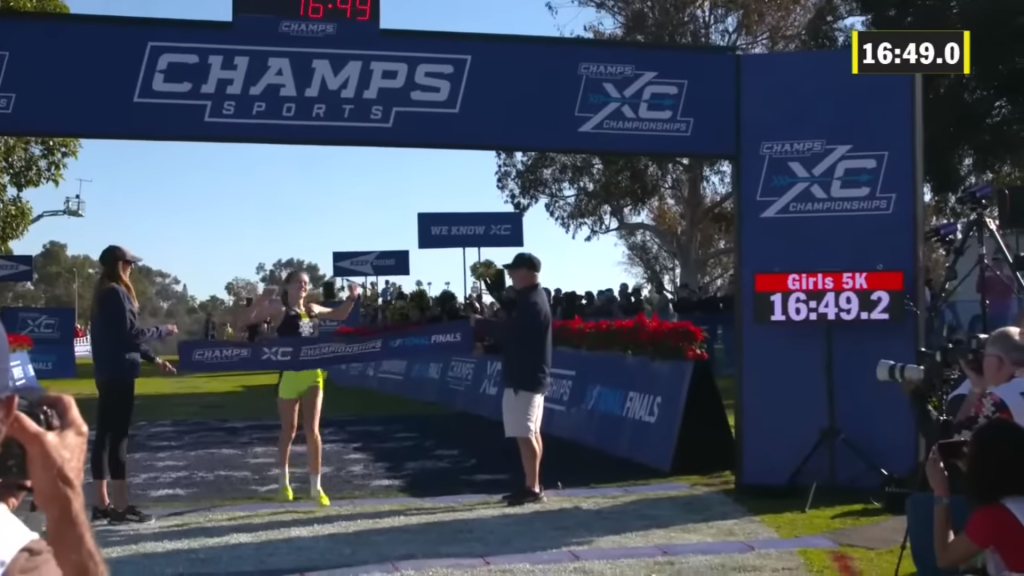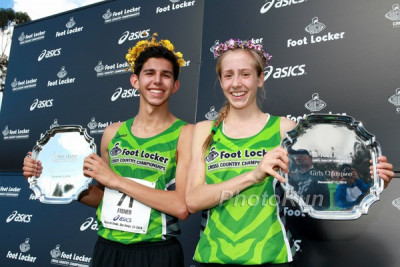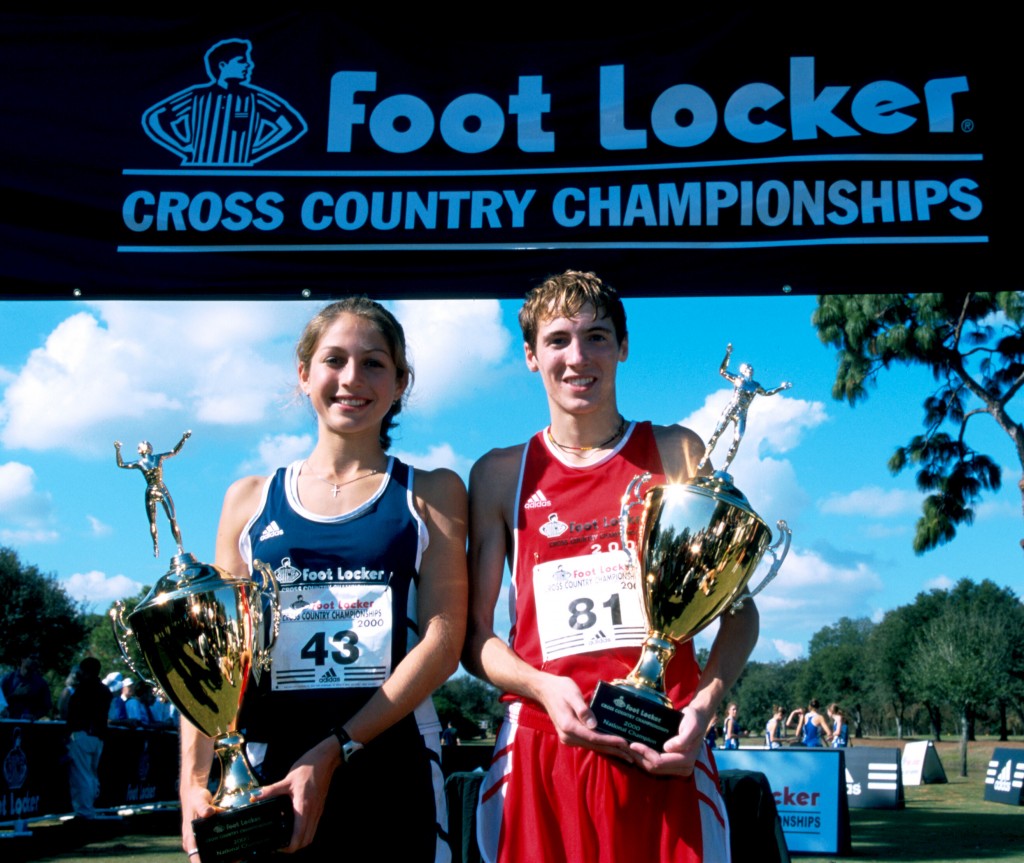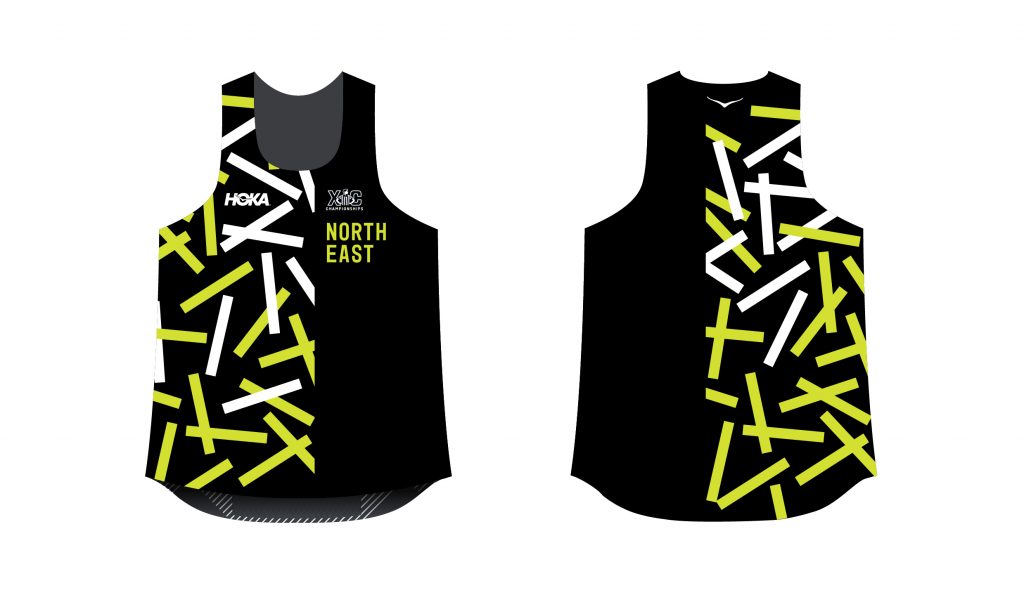The Foot Locker Cross Country Championships Are Back with an Old Name and a New Sponsor
The venerable meet navigated "murky waters" in recent years but has a new 3-year deal with HOKA
By Jonathan GaultFor runners of a certain age, the words “Foot Locker” conjure very specific memories: post-Thanksgiving trips to chilly courses in Wisconsin and the Bronx; testing oneself on Mt. SAC’s Poop Out Hill; for a lucky few, a free trip to sunny San Diego to be treated as kings and queens for a weekend. For decades, the Foot Locker Cross Country Championships were a constant on the high school calendar, with a legacy of champions that included the greats of the sport: Dathan Ritzenhein, Chris Solinsky, Jordan Hasay, Molly Seidel.
It’s harder to say what “Foot Locker” means to the current generation of high schoolers. When the 2023 Foot Locker Cross Country nationals are held on Saturday in Balboa Park, it will represent the first time the meet has been conducted under that name since 2019 — a year before any of this year’s participants had entered high school. For the athletes who will graduate in the spring of 2024, this is what the event has looked like the last four years:
2020: Meet cancelled due to COVID-19
2021: After 27 years as the Foot Locker Cross Country Championships, the meet returns with a new name: the Eastbay Cross Country Championships
2022: The name changes again, this time to the Champs Sports Cross Country Championships
2023: The meet returns to its previous name of Foot Locker Cross Country Championships
During that time, Foot Locker, Inc. — which owns the meet and also owns Eastbay and Champs Sports — was undergoing changes of its own. Dick Johnson, Foot Locker’s CEO since 2014, stepped down in September 2022 and was replaced by Mary Dillon. Jeanine Zocks, the longtime Foot Locker vice president in charge of the meet, was let go after the 2022 edition.
“I don’t think [the meet] has ever been in danger of going away but just like with any large corporation, it’s a huge expense,” says Tim O’Rourke, who has announced the meet for 25 years and is part of an unofficial steering committee of the meet, which includes the directors of the four regional meets. “There’s always infighting in any corporation of where the money will go. And that was the reason for the name changes…The internal reasoning was whoever’s budget was paying the bill, even though Champs and Eastbay are part of the Foot Locker family. When it was coming out of Eastbay’s bill, if you will, Eastbay wanted their name at the top. And when it came out of Champs, they wanted their name at the top.”
Those involved with the meet for many years knew the work that went into building the Foot Locker brand. The meet was known as the Kinney Cross Country Championships from its inception in 1979 until 1992, and many still widely referred to it as “Kinney” in the 1990s even once Foot Locker took over as title sponsor.
Peter Henkes, who has served as meet director of the Midwest Regional since 1984, said registration numbers for his meet have been down in recent years. Part of the reason, he said, was that some of the changes and uncertainty behind the scenes at Foot Locker contributed to getting a late start on organizing the meet in those years. He doesn’t think the name changes helped, either.
“People were concerned,” Henkes said. “Was it a different event?…It definitely hurt the meet. It had a huge negative impact on registration.”
2023, then, represents something of a new era for the oldest national high school cross country championships. The Foot Locker name is back. There’s a new man in charge of running the national meet, Jason Karlowski. There’s also a new Northeast Regional coordinator — 1998 Foot Locker champ Jorge Torres — and a new location for the NE regional as well, Boston’s Franklin Park. And there’s a new presenting sponsor: HOKA, who signed a three-year contract to support the meet (the official name is now Foot Locker Cross Country presented by HOKA).
Torres, who often returned to San Diego as a guest speaker at nationals in the years following his victory, said the meet had been navigating “murky waters” the last few years and credited Zocks for fighting to keep it alive. Now, he and the others charged with steering the meet believe the Foot Locker Cross Country Championships are in a strong place.
“Jeanine Zocks was the lifeblood of it for years,” O’Rourke said. “You can imagine in a meeting [at Foot Locker] where they talk about the NBA All-Star Game or the Super Bowl and somebody says ‘I want to spend a couple hundred thousand here on this high school event,’ everyone would kind of look at you…Now I think there’s a real commitment from both Foot Locker management and certainly we know we’re good for three years with HOKA. That’s a good deal. We’re going on 40 years plus now, and that’s something to be confident in.”
While the meet’s immediate future is secure, Foot Locker CC is no longer the only game in town. Over the last two decades, Nike Cross Nationals, has become a fixture on the high school calendar. And increasingly, it is the winners at NXN, rather than Foot Locker, who have been regarded as the country’s best XC runner — in part because western runners typically favor NXN, and in part because the last six FL boys’ champions were all defeated at another national meet before winning Foot Locker. Where, then, does a meet long billed as pitting the best against the best fit into a high school landscape where that may no longer be possible?
***
“When NXN came around, I thought they were just going to destroy us”
In 2004, Nike announced it was staging a new meet: Nike Team Nationals, the brainchild of Josh Rowe and John Truax. The conceit was simple. Cross country was a team sport, so NTN, as it became known, would do what Foot Locker did not and crown a team national champion. For the first three years, NTN and Foot Locker coexisted and even cooperated. With NTN taking place on the same day as the Foot Locker West Regional, Foot Locker expanded its field in 2005 and 2006 so that the top two finishers at NTN on teams from the West Region were offered berths at Foot Locker nationals.
But the alliance could not hold. Nike saw a chance to replicate the NCAA championships and crown team and individual champions in the same race. Nike added regional meets in 2007, some of which conflicted with Foot Locker regionals, and announced in 2008 it was rebranding as Nike Cross Nationals (NXN) while expanding the field to include individual qualifiers.
Foot Locker had a 25-year head start and history on its side, but NXN had a number of built-in advantages. Immediately, NXN became the #1 choice for top individuals who also happened to run for strong teams. It offered eight regionals instead of four, cutting down on travel for many families: instead of flying to Charlotte for Foot Locker South, Texas athletes could stay home and run NXN’s South regional in Houston. The timing of NXN’s Southwest and Northwest regionals also benefited NXN, with many of those regions’ top athletes opting to run NXN rather than waiting until Foot Locker West. NXN’s last nine boys’ individual champions have hailed from the west, while Foot Locker has not had a boys’ champion from the west since 2006.
“When NXN came around, I thought they were just going to destroy us, that we would never survive,” O’Rourke said.
But that did not happen. Foot Locker fields took a bit of a hit, but Henkes said his meet felt the biggest impact when it came to athletes who were not likely to contend for a berth at nationals.
“If somebody’s an hour away from South Dakota (site of NXR Heartland) and they’re five hours away from Kenosha, Wisconsin, (site of FL Midwest) and they just want to take their kids to a good experience, well of course they’re gonna go to the Nike meet,” Henkes said.
Even after NXN began accepting individual qualifiers in 2008, Foot Locker continued to attract the very best individuals for a number of years. Some athletes, like Lukas Verzbicas, ran both meets. Others, like Edward Cheserek and Grant Fisher, ran Foot Locker only. But things began to shift in the mid-2010s, with more of the top talents choosing NXN over Foot Locker, in part because of another built-in advantage: NXN did not force California athletes to run a regional meet, instead offering invitations based on their performance at the state meet.
“The last five years in a row, the best boy in the country was a Californian,” O’Rourke said. “If you go from Liam Anderson and then to Nico [Young] and Colin [Sahlman] and the Youngs and all the rest, it was always a California kid. They had the option, but it didn’t take a mental genius to realize when someone says, you don’t have to run the regionals, here’s your ticket, go to the nationals and then we come along and say, ‘Well you’ve still gotta come run our regional and maybe you’ll get to the nationals.'”
It also did not help that Katelyn Tuohy chose NXN three years in a row from 2016-19 or that the last six Foot Locker boys’ winners all ran and lost at either NXN or the RunningLane Cross Country Championships.
Foot Locker champions, 2016-22
| Year | Boys’ winner | NXN result | Girls’ winner | NXN result |
| 2016 | Reed Brown | 6th | Claudia Lane | N/A |
| 2017 | Dylan Jacobs | 13th | Claudia Lane | N/A |
| 2018 | Cole Hocker | 2nd | Sydney Masciarelli | N/A |
| 2019 | Josh Methner | 2nd | Zofia Dudek | N/A |
| 2021 | Riley Hough | 5th* | Natalie Cook | 1st* |
| 2022 | Kole Mathison | 4th | Karrie Baloga | N/A |
*There was no NXN in 2021 due to COVID; Hough and Cook ran at RunningLane instead, which effectively served as an NXN replacement that year
It’s clear that NXN is here to stay, and RunningLane, the Alabama-based meet that sprung up to fill a void in the COVID year of 2020, is not going away either, though the fields there have been weaker the last two years as NXN and Foot Locker have returned. A merge is unlikely at this point — the NFHS, the governing body nominally in charge of high school sports, lacks the power to enforce one, and both NXN and Foot Locker have spent too much time and money building up their meets to give in to the other.
“Both companies are shelling out way beyond the entry fees to put these events on,” Henkes said. “They’re both impassioned by the sport and want to put on a good event for the kids.”
***
Looking to the future
Midway through its fifth decade, Foot Locker’s main appeal remains its history. Save for few brief stretches in Orlando, Foot Locker nationals has been held on the same Balboa Park course in San Diego since 1979. Ellie Shea of Belmont, Mass., who was 2nd at Foot Lockers in 2022 and finished 10th in the U20 race at World XC in February, will be returning to Foot Lockers this weekend because of that history.
“The opportunity to compete on a course and measure your performance against all the other greats who have gone before is pretty awesome,” said Shea’s coach Fred Treseler. “You don’t have that opportunity at NXN.”
And when it comes to alums, there’s no contest. Matthew Centrowitz, Galen Rupp, Bob Kennedy, Meb Keflezighi, Deena Kastor, Emily Sisson…all of them ran at Foot Lockers as high schoolers, which brings back its greats, year after year, to create links across the generations.
“Being a young boy, when I started running at a high level and being a freshman qualifying for my first national championship, hearing about Bob Kennedy, Todd Williams, Marc Davis, Matt Giusto, I started doing my research, and I’m like, woah, these guys are awesome,” Torres said.
The challenge faced by those at Foot Locker is honoring that history while adapting to the realities of the present. The competition from NXN is real, and as the years go on, NXN will be able to claim history of its own. Katelyn Tuohy ran at NXN. So did 2023 NCAA XC champion Graham Blanks.
One potential area for change is making it easier for the best athletes to run NXN and Foot Locker. In 2023, for the first time, Foot Locker offered at-large spots to two top California athletes, Sadie Engelhardt and Emmanuel Perez, meaning they would advance straight to nationals without having to run the West Regional. Both athletes accepted the invitations initially, which would have brought this year’s Foot Locker field to 41 athletes in each race, but ultimately both Engelhardt and Perez withdrew after running NXN last weekend.
O’Rourke said that, moving forward, Foot Locker could offer more at-large entries, whether based on previous Foot Locker finish (a bye for the defending champion?) or that year’s NXN results.
“Everybody thinks this is a good idea in some form,” O’Rourke said.
One major change already happened in 2023: Foot Locker moved its Northeast Regional from Van Cortlandt Park in New York City to Franklin Park in Boston. For a meet that prides itself on its history, moving away from VCP is an odd choice, given it has hosted almost every Northeast Regional since 1979. Torres, who took over as meet director after Phil Zodda retired, lives in Dedham, Mass., and admitted practical concerns helped drive the change in location. Though he was quick to add that Franklin Park has history of its own.
“For me to give [the meet] the quality and support it needs, it would have to be near where I live,” Torres said. “And there’s definitely a lot of history in Van Cortlandt, but there’s plenty of history at Franklin Park – home to the World Championships in 1992. Bringing a little bit of a new event to a historic park might actually be good for the event itself…If I do my job well, I feel like a lot of kids are going to benefit from being able to come here on a yearly basis and challenge themselves on a great course.”
O’Rourke said that so far, HOKA has been an ideal partner — cooperative but not overbearing. Ian Hill, HOKA’s director of US marketing, said the brand is closely studying both Foot Locker regionals and nationals this year for ways to improve the experience. Any changes from HOKA are more likely to come at the regional level.
“Nationals is what gets most of the focus and press,” Hill said. “It’s where the live stream is. But we also believe the regionals is where we can have a really big impact on the experience for the kids because there’s 13,000 or so kids racing at regionals versus 80 at nationals. An objective for HOKA broadly is how can we invite more people to that starting line. Regionals is the way to do that.”
***
In the short term at least, high school cross country will continue to crown multiple national champions every year. That is a source of frustration for observers who want to see definitive best of the best matchups.
“I’m not going to say that NXN doesn’t have a place in high school cross country because there is a place for NXN,” Torres said. “But for me personally, I just wish, and I think a lot of fans agree with this – they wish that there was one true national championship. It’s a shame that it’s not like that.”
The solution is simple: merge the meets. The implementation, and the corporate cooperation it would require, is not. And even if a merge were to happen one day, the sport would be losing something valuable. Part of the appeal of Foot Locker is its uniqueness. With just 40 athletes per race and no team scoring, the focus is entirely on the individuals. There is not another cross country meet like it, and even if Foot Locker wanted to add teams, the Balboa Park course is not wide enough to accommodate 200 athletes. And without Balboa Park, is it even Foot Locker anymore? The fantasy many like Torres envision — a true national championship, without losing the history of Foot Locker — simply is not feasible.
Henkes would like to see the sport return to what it had from 2004-07, with Nike crowning team champions and Foot Locker crowning individual champions, but knows it is unlikely NXN returns to the days of team-only. O’Rourke, meanwhile, has come to terms with the current situation. NXN’s presence has undoubtedly made Foot Locker’s fields weaker, but O’Rourke says that more elite racing opportunities for the best athletes is not necessarily a bad thing — though Foot Locker will continue to compete to get the very best athletes at its meet.
“When we have these discussions with Foot Locker people, all the time it’s, we want to be the only one,” O’Rourke said. “We’re not going to be the only one. Let’s just be really good at it and give more opportunities and see what we can do.”





